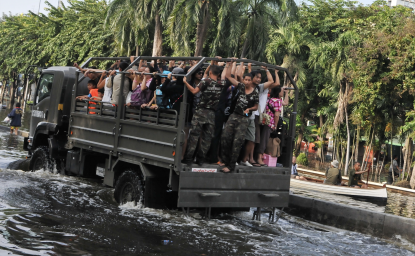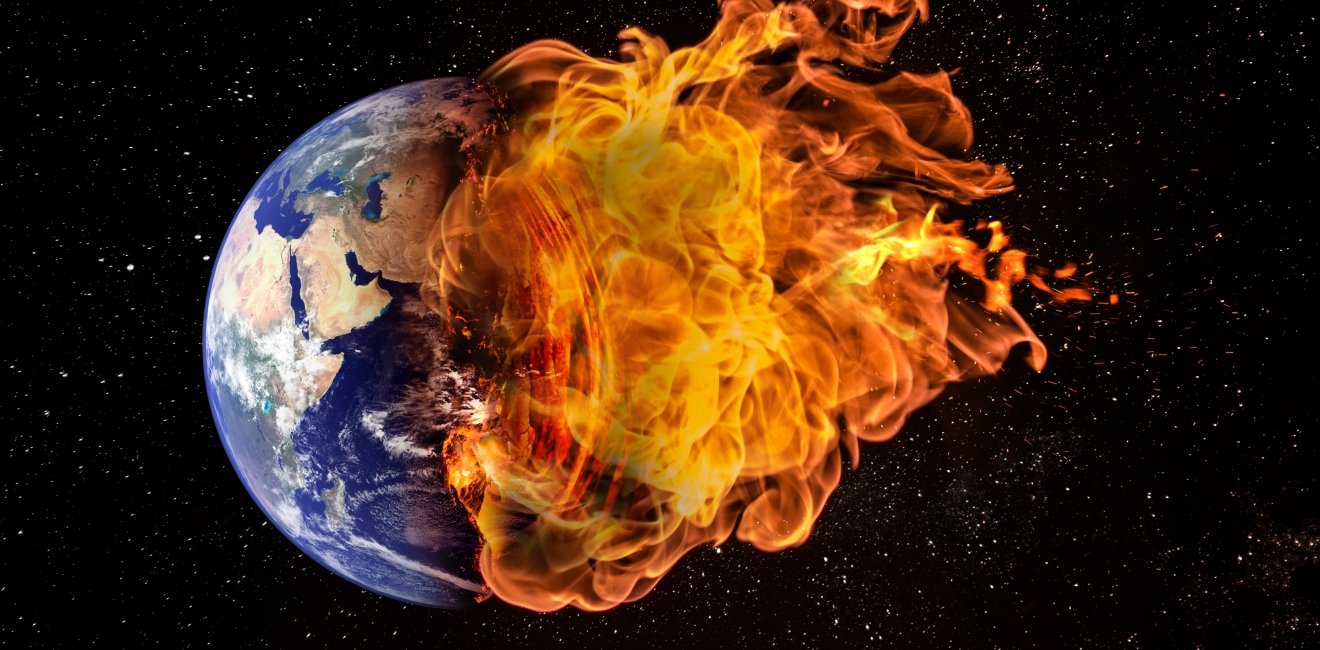Humanity faces two catastrophic, indeed existential, threats—climate change and nuclear war. These risks play out before us as if on split screen. On one side are the here-and-now impacts of climate change: wildfires from Siberia to California to southern Europe, scorching “heat domes” over the Pacific Northwest, and “once in a thousand years” flooding in China. On the other, heightened geostrategic competition carrying the greatest risk of war between nuclear powers since the depths of the Cold War: in the month of April 2021 alone, a Russian troop surge on the Ukraine border triggered an “imminent crisis” alert in NATO while Chinese naval vessels and bombers conducted a largescale war-game encircling Taiwan. Though ostensibly discrete, the events playing out on the split screen are linked. This new nexus between geostrategic competition and climate change must be understood and integrated in policy if the twin threats are to be averted.
In his landmark book, Hot, Flat, and Crowded, New York Times columnist Thomas L. Friedman stated that the central challenge of climate change to humanity is now “to manage what is already unavoidable and avoid what will truly be unmanageable.” To that compelling formulation can be added a corollary reflecting the new nexus: avoiding unconstrained geostrategic competition is a prerequisite for managing the climate threat.
The window for humanity to avoid unmanageable climate change is narrowing. The United Nations’ Intergovernmental Panel on Climate Change (IPCC) reports that global temperatures will inexorably rise 1.5 degrees Celsius above pre-industrial levels by mid-century because of the projected level of atmospheric carbon. The IPCC starkly warns that the dire consequences arising from a temperature increase beyond that point can only be averted through prompt concerted global action to bend the curve and sharply reduce atmospheric carbon. UN Secretary-General António Guterres called the report a “code red for humanity.” China, the United States, and Russia are, respectively, the first, second, and fourth largest carbon emitters.
Yet at the precise historical juncture when unprecedented global cooperation is necessary to forestall catastrophe, the world is on the brink of unconstrained geostrategic competition. Indeed, U.S. relations with Russia and China are the worst they have been since the end of the Cold War, with a recent Department of Defense policy document warning of an “increased potential for regional conflicts involving nuclear-armed adversaries … and the potential for adversarial nuclear escalation in crisis or conflict."
One could logically argue against a linkage—that if the great powers have a mutual interest in averting a climate catastrophe then cooperation in that area could be compartmentalized from geostrategic tensions. But the onset of unconstrained geostrategic competition negates the possibility of compartmentalization. Contrasting positions on the nexus—the linkage between geopolitical competition and climate change—were evident in an exchange between Chinese Foreign Minister, Wang Yi and former Secretary of State John Kerry, now the Biden administration’s Special Presidential Envoy for Climate during his visit to China in August 2021. Wang warned that cooperation on climate change “cannot possibly be divorced” from other geopolitical tensions, while Kerry countered that climate change is neither “a geostrategic weapon” nor “ideological”….but “a global, not bilateral, challenge.”
These contending perspectives divide along political theorist Arnold Wolfers’s classic dichotomy between “possession goals” and “milieu goals.” Possession goals relate to the preservation or enhancement of a state’s narrow national interest—for example, in relation to territory or trade relations. In contrast, milieu goals pursued by a state aim to shape and improve the international political environment beyond parochial national interest—which in this context relate to the fostering of favorable conditions for concerted action on climate change.
Applying this framework, the Chinese Foreign Minister’s comment suggests that climate change is viewed within the context of furthering conventional Chinese possession goals—that cooperation on climate change can be leveraged to gain advantage on another issue (such as Taiwan). Kerry’s rejection frames climate change as a milieu goal whose existential stakes transcend any one state’s national interests. Through Kerry, the Biden administration has signaled its aspiration to eschew efforts by other states to relegate climate change to just another issue in transactional diplomacy.
Yet on a macro level—elevating climate change to a milieu goal—the linkage between geostrategic competition and climate change is unavoidable. Even if unconstrained geostrategic competition does not lead to conflict that might itself trigger catastrophic global destruction, virulent relations between the United States and its great-power adversaries create a political environment in which close cooperation on climate change becomes difficult, if not impossible. For that reason the avoidance of unconstrained geostrategic competition is a prerequisite for addressing climate change. To be sure, avoidance does not mean the elimination of geostrategic competition, but rather, bounding it to mitigate the risks of conflict through effective management.
Avoiding Unconstrained Competition
New risk factors have brought the great powers to the verge of unconstrained geostrategic competition. An understanding of those risks provides insight into how they can be mitigated and thereby managed.
A New Calculus of Risk
Contemporary geopolitics is driven not by Cold War ideology, but by nationalism and expansive assertions of state sovereignty. Nuclear powers are engaged in strategic competition with the United States over the territorial status quo in areas of vital interest—for China, Taiwan and the South China Sea; for Russia, Ukraine and the periphery of the former Soviet Union. This contrasts with the Cold War era in which the superpowers engaged in competition in the regions of what was then called the Third World, which were clearly of peripheral interest. This geostrategic competition runs the risk of war through inadvertent escalation driven by miscalculation and misperception.
The territorial dimension, which could be the occasion for great-power conflict, is compounded by key developments affecting the nuclear deterrent relationship between the United States and its great-power adversaries. All the nuclear-weapon states have embarked on ambitious force modernization programs, and they are developing capabilities, such as low-yield nuclear weapons, which critics warn make them more usable in a crisis. The Trump administration’s Nuclear Posture Review claimed that the Russians had adopted an “escalate to deescalate posture” involving the first use of tactical nuclear weapons. Moreover, military escalation has traditionally been conceived as progressing from conventional to nuclear forces. With the advent of new technologies, however, escalation during a crisis would most likely occur in a non-traditional domain—cyber or space. Conflict escalation could plausibly take the form of a cyberattack to interfere with an adversary’s communications with its nuclear systems or an attack on reconnaissance satellites to blind an adversary. These developments could have the destabilizing consequence of creating an incentive for one side or the other to take preemptive action during a crisis.
Managed Competition
The contemporary pursuit of strategic stability is conditioned by the recasting of the traditional tension between two Cold War dynamics. The first is the so-called “stability-instability paradox,” which captures the dynamic in which a nuclear stalemate between adversaries may embolden lower-level aggression on the regional level. The second is what Cold War strategist Albert Wohlstetter described as the “delicate balance of terror” which emphasized the maintenance of a stable and robust deterrence, thereby removing any incentive for one power or another to strike first in a crisis.
As during the Cold War, this tension can be managed, but it cannot be resolved. Key elements—some aspirational, others operational, many surrounded by uncertainty—will affect the prospects for successful management:
Resolve/Manage regional flashpoints—The best way to avoid conflict among nuclear-weapon states is to redouble diplomatic efforts to address the territorial disputes that could precipitate it. To be sure, if these territorial issues were easy to resolve, they would have been. In some instances, domestic politics in one or both parties may be an impediment to resolution; in others, the discrete territorial issue may be a proxy for a more deeply rooted source of enmity or grievance. If resolution is not possible, conflict management may be. For example, the Code for Unplanned Encounters at Sea (CUES), to which both China and the United States are signatories, may be a mechanism for managing maritime tensions between their navies.
Maintain the residual arms control architecture—The new START treaty has been extended until 2026 and provides certainty and time for Russia and the United States to agree on a successor arrangement and outstanding issues (such as non-strategic nuclear weapons and engaging or taking Chinese capabilities into account).
Do not blur conventional and nuclear operations to prevent inadvertent escalation—Placing conventional warheads on ballistic missiles, such as that envisioned through the “Conventional Prompt Global Strike,” has utility (the ability to reach any target on the globe in under one hour), but runs the risk that Russia may perceive (and respond to) the launch of a ballistic missile that it associates with U.S. nuclear capabilities as the initiation of such an attack. Another potential driver of inadvertent escalation, with implications for both Russia and China, is the targeting of an adversary’s conventional capabilities that are co-located with its nuclear capabilities.
Mitigate risks through strategic dialogue—In the absence of an arms control architecture, each nuclear power in the multipolar system will have strategic autonomy to structure its offensive and defensive systems. All of the nuclear-weapon states have long been uncomfortably ambivalent with vulnerability captured in the acronym MAD—mutual assured destruction. But since the Cuban missile crisis, assured retaliation—eliminating incentives for a surprise first strike—has been the sine qua non of strategic stability. The risk now is that an unconstrained arms race (unregulated numbers of offensive and defensive systems, in tandem with new weapons technologies and cross-domain threats to space and cyber assets) could revive those incentives and undermine the deterrent relationships. In the past, arms control negotiations provided a forum for strategic discourse. “On a bilateral or a multilateral basis,” scholars Christopher Chyba and Robert Legvold argue, “the United States, Russia, and China should pursue discussions intended to improve understanding of one another’s strategic concerns and views on which actions by an adversary would be especially concerning or dangerous.” The focus should be on negotiated restraints (e.g., a ban on the deployment of anti-satellite weapons) to enhance stability and reduce incentives for one side or the other to act preemptively during a crisis.
Managing the Geopolitics of Climate Change
When George Kennan, the diplomatic architect of U.S. containment policy, declared the end of the Cold War, he explained that the Soviet Union under Mikhail Gorbachev had evolved from a revolutionary state into an orthodox great power—the country “should now be regarded essentially as another great power, like other great powers.” Kennan was essentially arguing that Russia’s post-Soviet foreign policy, stripped of ideology, was a renationalized version of traditional Russian foreign policy with strategic priorities starting with the “near abroad” of the former Soviet republics abutting the West.
A “risen” China presents an analogous case of an orthodox great power making assertive claims of territorial sovereignty on its periphery. This new superpower is deeply integrated into the global economy and presents a variegated challenge in a way that Russia, a one-dimensional superpower, does not. War between the United States and China is not inevitable, but the world’s two dominant powers could mismanage their way into it.
That Russia and China are orthodox great powers, not revolutionary states seeking the overturn of the international order, creates political space for the United States to initiate strategic dialogues with them separately or together to lower tensions and reduce the risks of conflict—thereby fostering a favorable international milieu to address the exigencies of climate change.
Precedents for such high-level strategic dialogue include the historic summit meetings that President Richard Nixon and Henry Kissinger conducted with the Soviet and Chinese leaderships in the early 1970s. Those summits yielded foundational documents such as the “Basic Principles of Relations” and “Agreement on the Prevention of Nuclear War” with the Soviet Union and the “Shanghai Communique” with China. But the era of improved relations with the Soviet Union foundered before the end of the decade because détente is a condition, not a structure of international relations.
Contemporary strategic dialogues between the United States and its great power adversaries could establish what Biden administration officials describe as “guard rails” to avert conflict. Competition will continue but it can be managed. But the deep virulence of the current relationships all but negates the prospect of such strategic management. The source of the virulence is deep-seated: each side sees the other as a revisionist state.
Fueled by renationalized foreign policies, Russia and China are breaching the territorial status quo along their peripheries. But the hard reality is that should the globally disruptive consequences of climate change projected by the IPCC transpire by mid-century, the territorial stakes driving geostrategic competition would be of secondary concern.
American policymakers depict the United States as a status quo force in international relations. But from the perspective of China and Russia, after the wars of regime change in Kosovo, Iraq, and Libya, the United States is viewed a revisionist state. Indeed, in Beijing and Moscow, the leadership perceptions are that the U.S. intention is essentially to promote regime change—for example, the Chinese point to speeches by senior Trump administration attacking the ruling role of the Chinese Communist Party.[1] Moreover, America’s frontal attacks on the regimes are personalized, as when President Biden called Vladimir Putin a “killer.”
An alternative U.S. strategy, harking back to Kennan and Kissinger, would decouple the regime change/regime evolution question (which is on an indeterminate timeline) from a pragmatic mixed strategy combining elements of containment and engagement to address security and climate issues (which are an urgent necessity). The United States would balance Russian and Chinese power, but look to internal forces within those societies as the agents of change.
A “Basic Principles” for a new era among the United States, Russia, and China could include provisions proscribing changes in the territorial status quo by force and non-interference in each other’s political orders. Avoiding unconstrained geostrategic competition in favor of managed competition would create a basis for improved cooperation on climate change. That requires not only a reduction of the virulence in the current relationships, but also a hitherto missing convergence of perspectives and interests. The prospects for such a convergence on climate change are uncertain. For all three great powers, the gap between rhetoric and reality is glaring.
With Kerry’s appointment by the Biden administration, the United States is signaling its leadership on climate change and pushing for concerted international action in advance of the United Nations climate summit (COP 26) in Glasgow in November 2021, but the long-term commitment of the United States is in question as the previous administration withdrew from the Paris Agreement.
Putin emerged from his international isolation to participate in the U.S. conference on climate, but has taken no concrete steps to back up his rhetoric supportive of international action on climate change. The conventional wisdom was that Russia would benefit from climate change as it would make its frozen north accessible for development. But the summer 2021 fires in Siberia and the 100 degree temperatures melting permafrost and collapsing Russian infrastructure may precipitate a change in perspective and interest.
China holds a unique position in the calculus of climate change. Kerry warned that the current Chinese plan to construct additional coal-fired reactors could alone "undo the ability of the rest of the world to achieve a limit of 1.5 degrees." Not wanting to appear to be succumbing to U.S. pressure, the Chinese Foreign Ministry stated, “President Xi Jinping has repeatedly emphasized that [we] address issues on climate change not because other countries ask us to, but because we want to do it ourselves." During the unprecedented flooding in southern China in July 2021 the Chinese state-controlled press made no mention of climate change as an exacerbating factor.
If constrained competition can usher in a new era of managed competition through strategic dialogue then international diplomacy on climate change can be recast. That diplomacy could yield a complex mix of overt cooperation and parallel actions. But as political scientist Jeff Colgan warns, “it might not be so easy to isolate decarbonization from tradeoffs with other policy issues.”
That is the crux. The avoidance of unconstrained geostrategic competition creates an occasion for revitalized climate diplomacy but does not assure a convergence of perspectives or successful outcome. As articulated by John Kerry, the prevention of catastrophic climate change is a transcendent issue of global import (a mileu goal) that should be ring-fenced from other issues. Alternatively, Russia and China perceive climate change as an issue they can leverage or trade off to further their parochial national interests (possession goals). The United States must reaffirm the mutuality of interest in climate change—that it is not some unilateral U.S. priority—and deflect efforts by Moscow or Beijing to link it to another. That is the diplomatic terrain on which the struggle over climate policy will be waged.
Humanity is at an inflection point as it faces the twin threats of climate change and nuclear war. An historical vignette offers perspective. During the 1985 Geneva summit, President Ronald Reagan privately asked Soviet leader Mikhail Gorbachev if the two superpowers could suspend their Cold War differences and unite if the Earth was invaded by aliens. Today the world faces the functional equivalent in climate change. The most vital issue in international relations is whether the great powers can take concerted action to avert climate catastrophe—or will allow unconstrained geostrategic competition to undermine that urgent necessity.
The author would like to thank Baroness Catherine Ashton, Robert Daly, Christian Ostermann, Lauren Herzer Risi, Matthew Rojansky, Mitchell Reiss, Michael Sfraga, Ariel Levite, Joseph Pilat, and Paul Stares for their comments on the draft of this essay.
Sources
BBC News, CNN, Federation of American Scientists, Forbes, Intergovernmental Panel on Climate Change, Reuters, Smithsonian Magazine, The New York Times, The Washington Post, Wilson Center
[1] Thanks to Robert Daly, Director of the Wilson Center’s Kissinger Institute on China and the United States, and Matthew Rojansky, Director of the Kennan Institute, for their insights on this issue.
Author


Environmental Change and Security Program
The Environmental Change and Security Program (ECSP) explores the connections between environmental change, health, and population dynamics and their links to conflict, human insecurity, and foreign policy. Read more


Polar Institute
Since its inception in 2017, the Polar Institute has become a premier forum for discussion and policy analysis of Arctic and Antarctic issues, and is known in Washington, DC and elsewhere as the Arctic Public Square. The Institute holistically studies the central policy issues facing these regions—with an emphasis on Arctic governance, climate change, economic development, scientific research, security, and Indigenous communities—and communicates trusted analysis to policymakers and other stakeholders. Read more

Explore More
Browse Insights & Analysis
Can Climate-Resilient Agriculture Become an Engine for Syria’s Post-Conflict Recovery?

ECSP Weekly Watch | March 10 – 14

ECSP Weekly Watch | February 17 – 21

